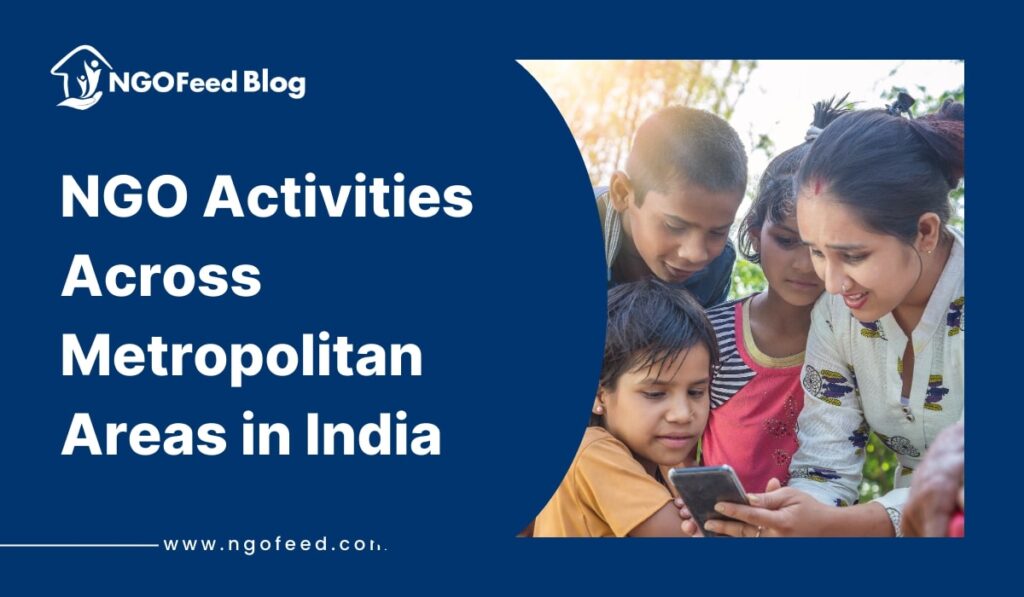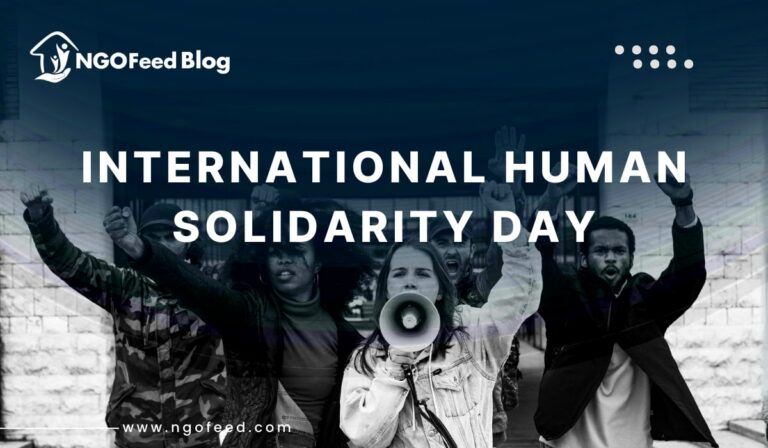NGO Activities Across Metropolitan Areas in India: Metropolitan areas across India form dynamic growth centers that combine economic power with cultural variety and cutting-edge technology. Urban centers host large populations and cities across India, creating the economic and social framework for their country’s nationwide development. Metropolitan areas like Mumbai, the financial center, and Delhi, the heart of history, display different aspects of Indian culture in one place. Bangalore and Hyderabad stand out for their worldwide IT success but Kolkata and Ahmedabad demonstrate perfectly how modernity mixes with tradition.
Indian metropolitan areas function as diverse societies that show India’s fast urban progress while hosting people moving between places. These hubs host large numbers of people with different origins who mix different languages trades and ways of life. These cities house important national infrastructure projects and offer three leading educational healthcare and manufacturing facilities.
Metropolitan areas in India encounter serious problems with population density, environmental threats, and limited infrastructure. Policymakers must work to grow their communities without damaging the environment to make cities more livable. This research article studies India’s city metros by examining their special traits while exploring their impact on national progress alongside their current difficulties and possible development.
Table of Contents
Top NGO Activities Across Metropolitan Areas in India
NGOs in Mumbai: The Financial Hub
Mumbai functions as the main financial center of India and people give it the nickname “City of Dreams.” Mumbai serves as the global financial center by providing headquarters for the Bombay Stock Exchange and leading multinational companies that support the national economy’s growth. The city’s film studios Bollywood help make Mumbai an important part of international culture. As key community stakeholders, NGOs help solve urban problems including slum resettlement of poor city residents and protecting the environment.
NGOs in Delhi: The City Holds Power Both Politically and Historically
At the center of India, you will discover Delhi where historical heritage mixes with contemporary development. In its role as the national capital, it hosts decision-making activities between the government and administrative entities. NGOs in this area work on many different efforts such as managing traffic and pollution while serving the needs of disadvantaged people through education.
NGOs in Bengaluru: The Silicon Valley of India
The city of Bengaluru operates as a major international technology and creativity center. The city welcomes tech whizzes from worldwide for its developing startup economy. In Bengaluru tech firms and NGOs team up to develop solutions for city issues including traffic relief programs and digital training while protecting the environment.
Hyderabad NGOs: The Emerging Tech Hub
Hyderabad stands out as a major IT and pharmaceutical center while keeping its cultural values and developing contemporary building systems. NGOs in the city work to improve healthcare access while empowering women and helping poor residents in their fast-expanding metropolitan setting.
Chennai NGOs: The Gateway to South India
Chennai earns its reputation as a city that has established itself through its heritage, industry, and academic institutions. As an NGO center, the city serves as a leading location for marine protection groups as well as organizations that help coastal communities prepare for disasters and develop sustainably.
Kolkata NGOs: The Cultural Capital
People recognize Kolkata because of its artistic achievements and its historic records. The people of Kolkata also deal with big issues in managing their city’s waste and poverty. Organizations in Kolkata focus their work on social welfare programs as well as protecting healthcare services and preserving historical sites.
Ahmedabad NGOs: It Confines Old Ways with New Developments
Ahmedabad combines cultural heritage with successful business development. Textiles and industry form strong bases of the city’s economy. NGOs in Ahmedabad primarily support urban developments and sustainable goals while serving marginalized residents.
These metropolitan areas both define India’s character and drive development through varied ideas and progress.
Role of Metropolitan areas in India’s economy
Economic Contributions of Metropolitan Areas
Key Industries and Sectors
Indian metropolitan regions maintain a central role in running the country’s economic foundation by hosting mission-critical industries that promote innovation and national expansion. Mumbai operates at finance and banking excellence while holding the Bombay Stock Exchange and providing the facilities for the entertainment industry that led to Bollywood.
Bengaluru, with Hyderabad, serves as a world leader in IT technology attracting international tech giants who also fuel new startup ventures. Automobile manufacturing and healthcare dominate in Chennai and textiles, together with jute production, form a base of strength for Kolkata. Ahmedabad stands out as a city concentrated on textile manufacturing along with chemical sector development. Together with generating economic growth these sectors position cities as major international players within their specific industry domains.
Role in National GDP
The metropolitan regions of India play a vital role in producing an impressive share of India’s national GDP. Mumbai together with Delhi and Bengaluru collectively produce most of the economic output for India as a nation. As the financial hub and commercial center of India, Mumbai produces one of the country’s largest financial segments that supports its entertainment industries. The information technology sector in Bengaluru produces annual billions which propels export growth and supports digital innovation initiatives. Metropolitan regions show extensive levels of business and industrial activity and service delivery which demonstrates their fundamental impact on India’s economic development pattern.
Employment Opportunities
Cities with metropolitan arrangements draw workers through a strong employment pull that extends across India. Job seekers can find multiple career options within these cities across Information Technology and finance in addition to manufacturing industries healthcare services and education institutions. Millions of workers establish their livelihoods through street vending and manual labor within urban areas because the informal sector operates successfully in these locations. Through their activities in metropolitan cities, NGOs help develop skills alongside ensuring fair pay and job placement opportunities for marginalized social groups for balanced economic advancement.
The analysis demonstrates how metropolitan areas drive India’s economic advancement by solving emerging problems due to fast urban growth.
Development of Urban areas and infrastructure
Transportation Networks
Academically India’s metropolitan regions maintain a complex web of transport infrastructure enabling mass movements throughout daily periods. The metro systems operating within the cities of Delhi Mumbai and Bengaluru help resolve traffic jams while reducing travel expenses compared to other options. Two major international airports within metros serve as India’s transportation gateways through the world with Delhi’s Indira Gandhi International and Mumbai’s Chhatrapati Shivaji Maharaj International airports. Urban mobility faces ongoing problems from traffic congestion along with restricted final-mile access between transport systems which NGOs and urban planners promote by advocating sustainable pedestrian infrastructure and cycling network development in addition to expanding public transportation systems.
Real Estate and Housing Challenges
Metropolitan cities currently experience such fast demographic expansion that it produces both inflated real estate costs and insufficient housing availability. Constructing houses in informal settlements and slums emerges as a major problem in cities including Mumbai and Kolkata because there is not enough affordable housing. The vital actions that non-government organizations (NGOs) perform include policy-based housing inclusiveness advocacy as well as slum redevelopment assistance through legal support for marginalized residents and people without housing options. Effective urban sustainability demands both universal housing access along solutions to address real estate speculation problems.
Smart City Initiatives
Through their Smart Cities Mission India intends to develop urban centers into technological and sustainable destinations. Pune Chennai and Ahmedabad have launched smart city developments which combine enhanced traffic control systems with energy-efficient goals and modern administrative methods. These programs establish cooperative structures between government entities and private sector organizations which incorporate NGO-specific knowledge about community outreach together with sustainability practices and social benefit measurements. Modern urban living transforms thanks to infrastructure design that integrates technology which produces more robust cities that respond better to new requirements.
The combined elements confirm how sustainable infrastructure creation creates metropolitan areas that remain eco-friendly and truly serve their populations.
Challenges Faced by Metropolitan Areas
Overcrowding and Urban Sprawl
The fast-growing population in metropolitan cities of India comes from rural to urban migration in pursuit of better opportunities. Rapid population growth has produced both overcrowded communities and inadequate services, as well as chaotic urban expansions. Unplanned urban growth into peri-urban regions creates numerous social and environmental challenges resulting from deficient infrastructure design.
Environmental Concerns: Pollution and Waste Management
The current air and water quality in Delhi’s metropolitan area frequently surpasses dangerous thresholds according to pollution measurement standards. Weak waste disposal systems result in the accumulation of trash which endangers both human health and the environment. NGOs serve as essential agents in fighting these environmental challenges through public education and their work implementing waste management programs and promoting waste segregation alongside sustainable practices that include composting and recycling.
Infrastructural Pressures
The rapid population expansion generates massive strain on urban infrastructure elements such as transportation systems water networks power grids and street networks. Traffic congestion especially affects Bengaluru and Mumbai adding to daily delays and productivity declines within these major cities. Chennai’s water scarcity conditions demonstrate the urgent necessity for enhanced resource control approaches and sustainable municipal development methods.
Housing Inequality and Slums
Two hundred thousand Indian residents cannot find affordable housing so they must settle for below-standard living accommodations in metropolitan environments. Areas designated as slums exhibit three main defining characteristics of misery: limited access to utilities, poor facilities, and excessive population density. Non-governmental organizations collaborate in these areas to raise the quality of life by promoting housing accessibility while delivering education programs healthcare solutions and career preparation.
Social Inequalities and Urban Poverty
Metropolitan areas manifest extensive economic differences among their residents. High-wage employment exists mainly in IT and finance businesses but exists alongside employment in low-skill sectors and informal economy work. Both government resources and social service organizations known as NGOs work to close the gap by offering training along with medical management as well as community assistance for disadvantaged groups.
Climate Change and Disaster Risks
Urban regions face rising threats from climate change which produces floods and heatwaves while causing ocean levels to rise. The cities of Mumbai and Chennai which face the sea stand as the most vulnerable targets. Metropolitan areas have formed alliances of government agencies and NGOs that build infrastructure systems that resist climate change and develop sustainable green spaces along with disaster preparedness plans.
Governance and Policy Implementation
Multiple administrative agencies controlling metropolitan areas create systematic inefficiencies when policies need to be executed. Proper urban management faces barriers from administrative corruption a lack of coordination and insufficient citizen involvement. The advocacy of NGOs functions as a bridge to press demands for transparent urban governance systems that integrate local communities and enforce responsible management practices.
Sustainable and inclusive urban growth requires a public-private-citizen NGO partnership to overcome current challenges.
Role in NGOs Metropolitan Areas
Addressing Urban Poverty and Inequality
The central economic areas of cities function as epicenters for development opportunities but continue to display intense divisions between these opportunities and inadequate services for their residents. Most communities live in informal housing areas without fulfilling basic service needs. Non-governmental organizations address urban poverty by delivering vocational training programs, microfinance support and essential resource distribution. Strategic programs focused on women’s empowerment and youth development together with support for marginalized communities, establish routes for poverty alleviation with simultaneous work toward achieving social equality.
Promoting Sustainable Development Initiatives
Fast urbanization produces systemic environmental destruction while simultaneously diminishing available resources and leading to sustainability hurdles. Non-governmental organizations lead the effort to establish environmentally sustainable practices in cities across the world. Sustainable development projects within their programs emphasize water conservation through waste management, together with renewable energy implementation and urban forest planting. A variety of initiatives to lower single-use plastic consumption together with public transportation promotion and sustainable building programs work to develop environmentally friendly urban areas. Local governments together with private entities work with NGOs to establish sustainable development programs that create meaningful impacts.
The organizations enhance educational and health services accessibility
Nonprofit entities function as critical elements that bond education and healthcare gaps across metropolitan areas. Through their establishment of free schools, subsidized educational facilities and digital learning centers they extend quality education opportunities to marginalized children and young people. The work of NGOs in healthcare includes running mobile clinics and offering health camps with awareness drives that deliver maternal care and immunization services as well as mental health support to underserved urban populations.
Urban advocacy requires NGO to work in partnership with each other on policy creation.
The field of urban governance benefits from NGO contributions because these organizations possess both subject matter expertise and practical community understanding. Non-government organizations employ their expertise through research along with community dialogues and policy advocacy efforts to design urban development plans that serve equity and sustainability goals. Public policy organizations work side by side with municipal administrations on housing affordability programs transport facilities and disaster preparedness initiatives. The advocacy work strives to engage citizens in government decisions while creating improved transparency alongside responsible governance practices.
Non-governmental organizations address these essential areas making metropolitan areas more sustainable while ensuring increased inclusivity and greater resilience to upcoming challenges.










